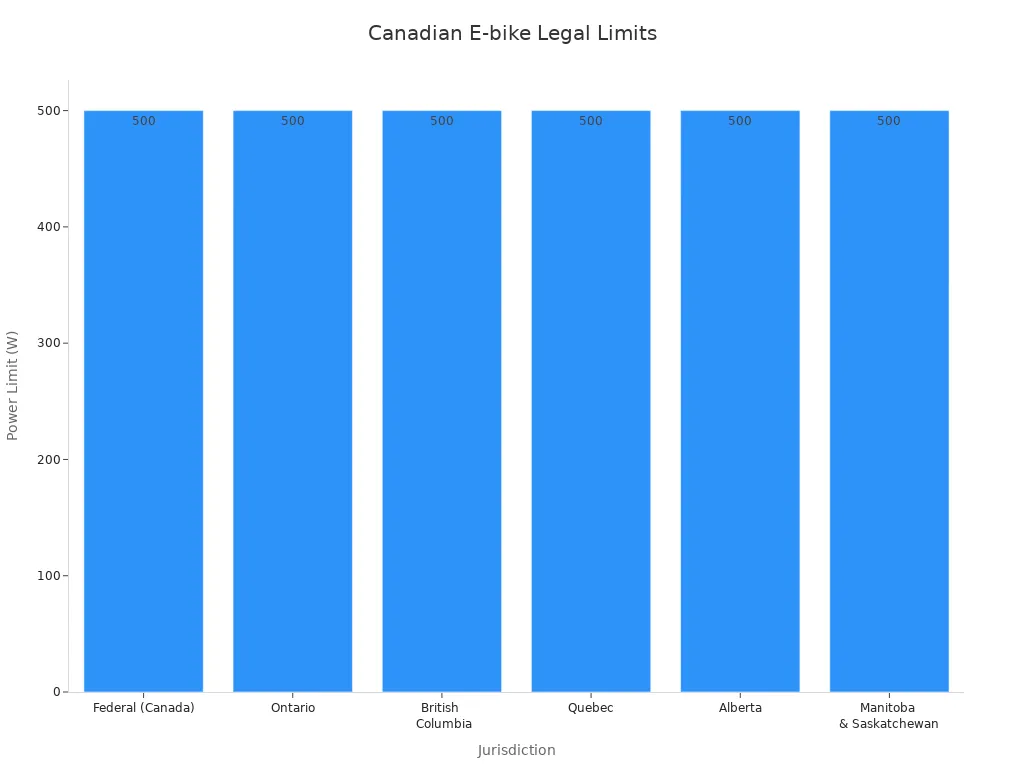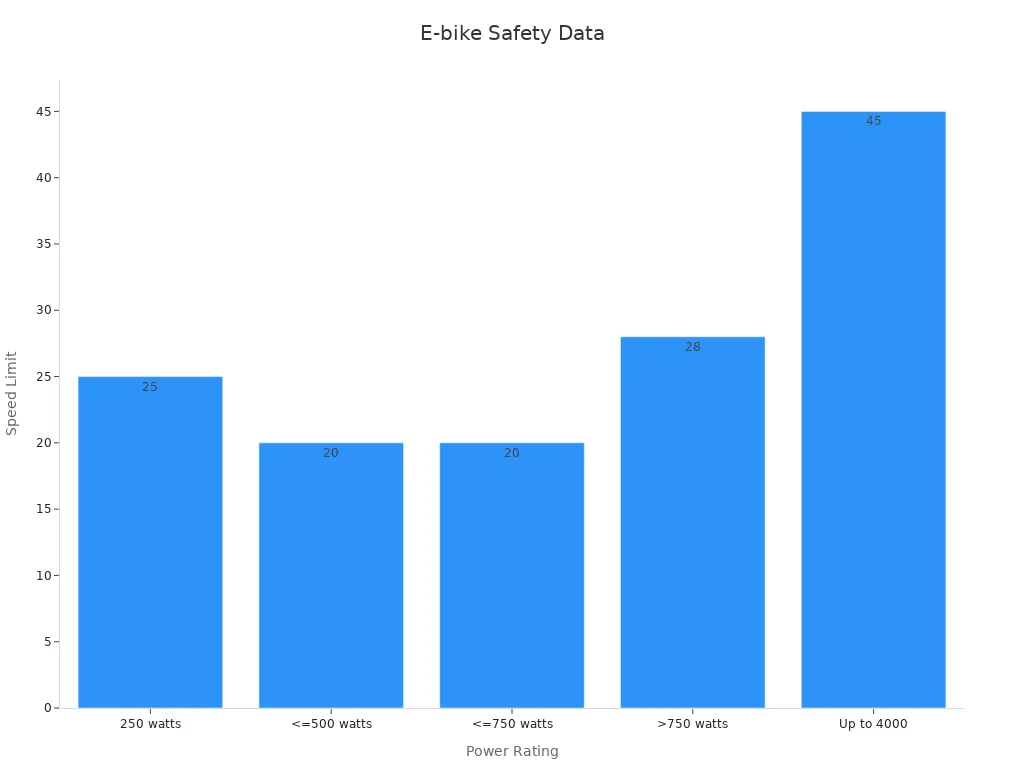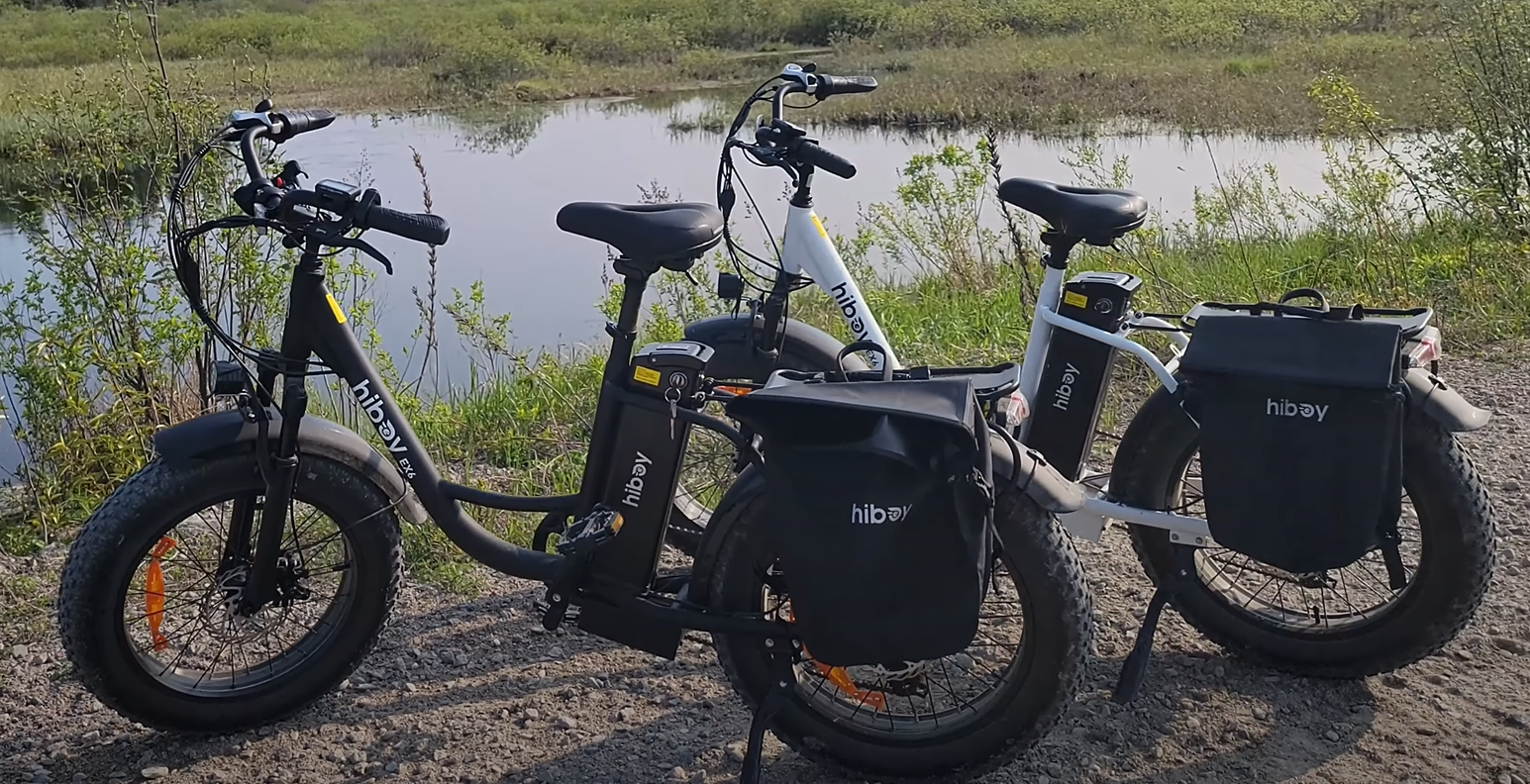You cannot use 750-watt electric bikes on public roads or paths in Canada. Federal laws set a 500-watt limit for e-bikes, so 750-watt e-bikes do not meet the requirements. Every province in Canada follows this same limit. If you want to ride electric bikes in Canada, you must keep to the laws about power and classification. Some off-road areas may allow e-bikes with more power, but each province and local area has its own rules.
Key Takeaways
-
Canada limits e-bike motors to 500 watts and a top speed of 32 km/h for street use.
-
750-watt e-bikes are not legal on public roads and may be treated as motor vehicles.
-
Riding illegal 750-watt e-bikes can lead to fines, insurance issues, and bike seizure.
-
Off-road use of 750-watt e-bikes depends on local rules; always check before riding.
-
Choosing a 500-watt e-bike ensures legal, safe, and hassle-free riding on public roads.
750-Watt Electric Bikes and Canadian Law

Federal Law Overview
You need to know that federal regulations on e-bikes in Canada set a clear legal wattage limit. The law says that electric bikes must have a motor output of no more than 500 watts. The speed limit of 32 kilometres per hour also applies to these bikes. If you ride an e-bike with more power or speed, it does not count as a regular e-bike under Canadian law. Instead, it may be treated as a motor vehicle.
Here are the main points from the federal rules:
-
E-bikes must have a motor output of 500 watts or less.
-
The maximum speed allowed is 32 km/h on level ground.
-
You must have steering handlebars and working pedals.
-
The motor must stop when you stop pedaling.
-
You cannot modify the motor to go faster than 32 km/h.
-
All e-bike riders must wear a helmet.
-
Only electric motors are allowed, not gas engines.
-
If your e-bike goes over 500 watts or 32 km/h, it may be classified as a motorcycle or moped.
An academic study on North American e-bike regulations points out that 750-watt electric bikes do not fit the Canadian definition of a low-speed e-bike. The study explains that these bikes could be seen as motor vehicles, which means you would face stricter rules. The law does not say 750-watt e-bikes are outright illegal, but it does make their use on public roads very difficult.
Provincial Rules
Every province in Canada follows the federal limit for e-bikes. This means you cannot use 750-watt electric bikes on public roads anywhere in the country. Provincial regulations match the federal rules, but some local differences exist. For example, some provinces set a minimum age for riders or have special rules for using e-bikes on sidewalks.
-
Alberta, British Columbia, Manitoba, New Brunswick, Newfoundland, Northwest Territories, Nunavut, Nova Scotia, and Ontario all use the 500-watt limit.
-
All provinces require helmets and set a speed limit of 32 km/h.
-
Some provinces have extra rules, like Manitoba banning e-bikes on sidewalks, while New Brunswick allows them.
-
Ontario and British Columbia have special speed limits in cities.
-
Some provinces require that the throttle cuts out at certain speeds or that the bike meets certain braking standards.
You should always check the local laws in your province before riding. Even though the main rules are the same, small differences can affect where and how you ride.
Why 750W E-Bikes Are Not Street-Legal
750-watt electric bikes are not street legal in Canada because they do not meet the legal wattage limit set by federal and provincial regulations. If you use a 750-watt e-bike, it will be classified as a motor vehicle. This means you would need to register it, get insurance, and have a driver’s license. Most people do not want to go through this process for an e-bike.
Here is a table that shows how different regions in Canada treat e-bikes with more than 500 watts:
|
Jurisdiction |
Legal Power Limit (Watts) |
Speed Limit (km/h) |
Classification & Requirements for >500W e-bikes |
|---|---|---|---|
|
Federal (Canada) |
500 |
32 |
>500W e-bikes classified as motor vehicles; require registration, insurance, driver's license |
|
Ontario |
500 |
Aligns with federal |
750W e-bikes not street legal; may require motor vehicle registration; riders must be 16+ and wear helmets |
|
British Columbia |
500 |
Aligns with federal |
>500W treated as limited-speed motorcycles; 16+ age and helmet required |
|
Quebec |
500 |
Aligns with federal |
750W e-bikes not allowed unless restricted; max weight 120 kg including battery/accessories |
|
Alberta |
500 |
Aligns with federal |
750W e-bikes not street legal unless restricted; must have operable pedals with bell/horn |
|
Manitoba & Saskatchewan |
500 |
Aligns with federal |
>500W e-bikes restricted from public roads; minimum age 14 in Manitoba |

You can see that the 500-watt limit is the standard across Canada. The rules make it clear that 750-watt electric bikes do not qualify as e-bikes for street use. If you want to ride legally, you must choose an e-bike that meets the 500-watt limit and follows all other regulations.
Exceptions and Off-Road Use in Canada
Off-Road Riding
You might think you can use a 750-watt e-bike on trails or in parks, but the rules are not always simple. Some off-road areas allow e-bikes with higher power, but you need to check the specific regulations for each place. In some regions, land managers use different classes for e-bikes. These classes help decide where you can ride and what kind of e-bike you can use.
Here is a table that shows how off-road e-bike classes work:
|
E-bike Class |
Motor Wattage Limit |
Assistance Description |
Speed Limit |
|---|---|---|---|
|
Class 1 |
≤ 750 watts |
Pedal assist only |
20 mph |
|
Class 2 |
≤ 750 watts |
Throttle allowed, no need to pedal |
20 mph |
|
Class 3 |
≤ 750 watts |
Pedal assist only |
28 mph |
Most off-road trails in parks or forests follow these classes. You must have working pedals and two or three wheels. Some trails allow all classes, but others only allow Class 1. Always look for signs or maps that show which e-bikes are allowed.
Tip: Before you ride, ask the park office or check their website for up-to-date regulations. Rules can change from one trail to another.
Local Restrictions
Local regulations and bylaws play a big role in where you can ride your e-bike. Even if a trail allows e-bikes, local rules might set extra restrictions. Across the country, most provinces set a 500-watt limit for e-bikes, even for off-road use. Municipalities can make their own rules about which e-bikes are allowed on paths, lanes, or trails.
Here is a quick look at how some regions handle off-road e-bike use:
|
Region |
Motor Power Limit |
Off-road Use / Local Restrictions |
|---|---|---|
|
Alberta |
500 W |
No allowance for 750 W; helmet required; local regulations may apply. |
|
British Columbia |
500 W |
Local regulations decide trail access; 750 W not allowed on public trails. |
|
Ontario |
500 W |
Municipalities can restrict e-bikes on trails; 750 W not allowed. |
|
New Brunswick |
500 W |
No 750 W allowed; homemade e-bikes without label not recognized. |
You should always check local regulations and bylaws before riding. Some areas may have stricter rules than others. If you ignore these rules, you could face fines or get your e-bike taken away.
Risks of Illegal 750-Watt E-Bikes
Fines and Penalties
If you ride a 750-watt e-bike on public roads in Canada, you risk getting fined. Police officers can stop you if they see you using a bike that does not meet the legal limit. Fines can range from $100 to over $1,000, depending on your province and the situation. Some places may also give you tickets for not wearing a helmet or for riding on sidewalks where it is not allowed.
Note: Fines can add up quickly if you break more than one rule at a time.
Insurance and Liability
You may think you do not need insurance for your e-bike, but this changes if you use a 750-watt model. Since the law treats these bikes as motor vehicles, you must have insurance if you ride them on public roads. Most insurance companies will not cover you if your bike does not meet the legal definition of an e-bike. If you get into an accident, you could be responsible for paying for injuries or damage out of your own pocket.
Here is a quick look at what can happen:
|
Situation |
Possible Outcome |
|---|---|
|
Riding without insurance |
You pay for all damages |
|
Causing an accident |
You face lawsuits or big bills |
|
Injuring someone |
You may have to pay medical costs |
Vehicle Seizure
Police have the right to take away your 750-watt e-bike if you use it illegally. If they stop you and find out your bike does not meet the rules, they can seize it on the spot. Getting your bike back can be hard and expensive. You may need to pay storage fees or prove you will not use it illegally again.
🚨 Always check the rules before you ride. Losing your e-bike can cost you much more than just a fine.
Legal E-Bike Alternatives

500W E-Bikes
If you want to ride on public roads in Canada, you should choose a 500W e-bike. These models meet all federal and provincial rules. You do not need a license, registration, or insurance for a legal electric bicycle with a 500-watt motor. This makes your ride simple and safe. You can use these e-bikes on bike paths, city streets, and many trails.
Here is a table that shows how 500W e-bikes compare to higher-powered models:
|
Power Rating (Watts) |
Speed Limit (mph or km/h) |
Classification |
Regulatory Requirements |
Safety & Compliance Implication |
|---|---|---|---|---|
|
<= 500 watts |
<= 20 mph (U.S.) |
Legal e-bike (Class 1 or 2) |
No license, registration, or insurance required |
Simplified compliance, safer use on bike paths and trails |
|
<= 750 watts |
<= 20 mph (U.S.) |
Legal e-bike (Federal limit) |
No license, registration, or insurance required |
Maintains bicycle classification, easier legal use |
|
> 750 watts |
> 28 mph (U.S.) |
Motor vehicle or moped |
Requires license, registration, insurance |
Subject to stricter laws, less safe on bike infrastructure |
|
250 watts |
25 km/h (Europe) |
Bicycle (EU standard) |
No license, no helmet required |
High compliance, widely accepted for bike lanes |
|
Up to 4000 watts |
Up to 45 km/h (S-Pedelec) |
Low-speed motorcycle (EU) |
Registration, insurance, helmet required |
More restrictions, less access to bike infrastructure |
You can see that 500W e-bikes offer the best balance of safety and legal access. Most riders in Canada pick these models for daily use.
Tip: Manufacturers design 500W e-bikes to give you enough power for hills and city riding while staying within the law.
Other Options for More Power
If you need more power, you can look at higher-powered e-bikes for off-road use. These models work well for mountain trails or carrying heavy loads. You must check local rules before you ride a high-powered e-bike off-road.

Here are some trends in the e-bike market:
-
E-bikes with 250W-500W motors are popular for their balance of power and efficiency.
-
Many people choose 500W e-bikes for their versatility and legal status.
-
High-powered e-bikes above 500W are growing in demand for off-road and cargo uses.
-
Manufacturers focus on making e-bikes that meet legal limits but still offer strong performance.
-
The global e-bike market is expected to grow from $48.7 billion in 2024 to $71.5 billion by 2030.
You can find a legal electric bicycle for almost any need. If you want more speed or torque, use a higher-powered model only where the law allows.
You cannot ride 750-watt electric bikes on public roads in Canada. Always follow the 500-watt limit to stay safe and legal. Before you buy or ride any e-bike, check your local laws. If you want more power or speed, look for legal alternatives that fit your needs.
Remember: Following the rules protects you and others on the road.
-
Choose a 500W e-bike for daily use.
-
Use higher-powered bikes only where allowed.
FAQ
Can you ride a 750-watt e-bike on private property in Canada?
Yes, you can ride a 750-watt e-bike on private property if the owner allows it. Public road rules do not apply on private land. Always ask for permission before riding.
Do you need a license to ride a 750-watt e-bike in Canada?
You need a driver’s license if you ride a 750-watt e-bike on public roads. The law treats it as a motor vehicle. You do not need a license for legal 500-watt e-bikes.
What happens if police catch you riding a 750-watt e-bike on the street?
Police may stop you and give you a fine. They can also seize your e-bike. You might need to pay extra fees to get it back.
Are there any legal ways to increase your e-bike’s power in Canada?
You can only use higher-powered e-bikes off-road where local rules allow. You cannot legally increase your e-bike’s power for street use. Always check local laws before making changes.
How can you tell if your e-bike is legal for street use?
Check the label on your e-bike. It should show the motor power (500 watts or less) and the top speed (32 km/h or less). If you cannot find this information, ask the manufacturer or dealer.











Share:
Electric Scooter Laws 2025 in Canada
Electric Scooter Regulations in Canada: A Rider's Guide to Staying Safe and Legal in 2025